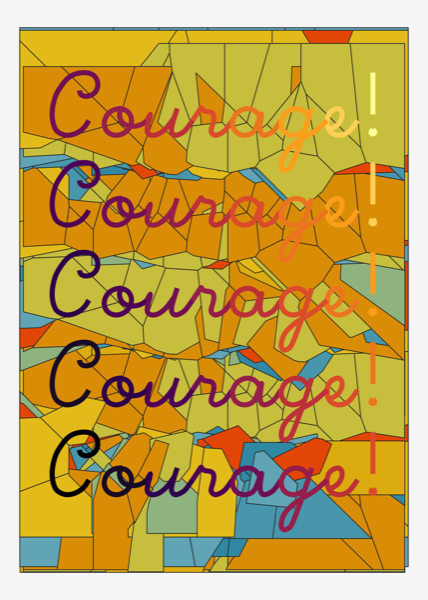#genuary 2021
This year was the first #genuary. It was really fun, I did more plots than I expected and learned a lot! All the plots were made in R, the code for every one of them is available on GitHub.
JAN.1 (credit: Piter Pasma)
// TRIPLE NESTED LOOP

JAN.2 (credit: Harold)
Rule 30 (elementary cellular automaton)


JAN.3 (credit: Sam Corzine)
Make something human.

JAN.4 (credit: Louis-André Labadie)
Small areas of symmetry.

JAN.5 (credit: Louis-André Labadie)
Do some code golf! How little code can you write to make something interesting? Share the sketch and its code together if you can.


JAN.6 (credit: Stevan Dedovic)
Triangle subdivision.
JAN.7 (credit: Louis-André Labadie)
Generate some rules, then follow them by hand on paper.
JAN.8 (credit: Licia He)
Curve only.

JAN.9 (credit: Sam Corzine)
Interference patterns.

JAN.10 (credit: Piter Pasma)
// TREE


JAN.11 (credit: Piter Pasma)
Use something other than a computer as an autonomous process (or use a non-computer random source).

JAN.12 (credit: Jonathan Barbeau)
Use an API (e.g. the weather). Here’s a huge list of free public APIs.

JAN.13 (credit: Louis-André Labadie)
Do not repeat.
JAN.14 (credit: Piter Pasma)
// SUBDIVISION



JAN.15 (credit: Louis-André Labadie)
Let someone else decide the general rules of your piece.
JAN.16 (credit: Aaron Penne)
Circles only

JAN.17 (credit: Louis-André Labadie)
Draw a line, pick a new color, move a bit.



JAN.18 (credit: Piter Pasma)
One process grows, another process prunes.

JAN.19 (credit: Piter Pasma)
Increase the randomness along the Y-axis.

JAN.20 (credit: Aaron Penne)
No loops.

JAN.21 (credit: Harold)
function f(x) {
DRAW(x);
f(1 * x / 4);
f(2 * x / 4);
f(3 * x / 4);
}
JAN.22 (credit: Louis-André Labadie)
Draw a line. Wrong answers only.

JAN.23 (credit: Richard Vigniel)
� Ša9d8f #e9c46a #f4a261 #e76f51, no gradients.
Optionally, you can use a black or white background.


JAN.24 (credit: Aaron Penne)
500 lines.

JAN.25 (credit: Piter Pasma)
Make a grid of permutations of something.

JAN.26 (credit: Stevan Dedovic)
2D Perspective.

JAN.27 (credit: Aaron Penne)
Monochrome gradients without lines.

JAN.28 (credit: Louis-André Labadie)
Use sound.

JAN.29 (credit: Aaron Penne)
Any shape, none can touch.

JAN.30 (credit: Jonathan Barbeau)
Replicate a natural concept (e.g. gravity, flocking, path following).
JAN.31 (credit: Piter Pasma)
10 SEARCH FOR "ENO'S OBLIQUE STRATEGIES"
20 OBTAIN ONE
30 THAT IS YOUR PROMPT FOR TODAY

